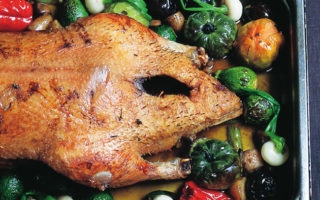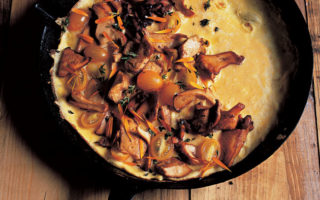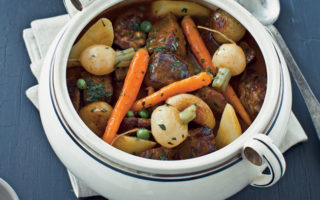Tagines – the north African connection
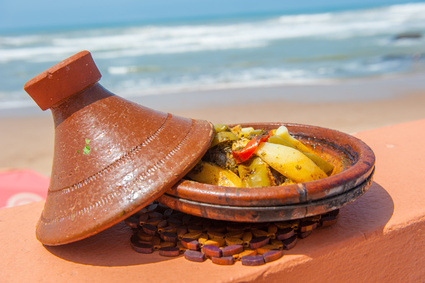

![]()
Travelling the length of the Côte d’Azur from Menton on the Italian border to Marseille you’ll be pleasantly surprised by the variety of vegetarian food you can find. Being so close to Italy pasta dishes and pizzas are freely available but your first real tagine could very well be the gastronomic highlight of the trip.
Here are some delightful tagine recipes from Andrea and Bruce who run a vegetarian chambres d’hôtes in the Creuse.
The word tagine refers both to a cooking utensil and the dish cooked in it – and being a phonetic translation from Arabic it is also spelled tajine.
Tagines are of course popular throughout France due to the historic connections with North Africa.
Tagines – the cooking vessels
Traditionally used by North African nomads as portable ovens over charcoal braziers, tagines are made from glazed or unglazed clay. The base is both a cooking and serving dish. It is very heavy so as to withstand constant use and to hold the heat longer. As steam is produced the cone-shaped lid acts like an oven and is totally sealed to retain heat and moisture. This not only allows the steam to circulate inside, preventing it from drying out during the long cooking process, but also allows the slow infusion of flavours throughout the dish. The low, indirect heat produces a rich, aromatic flavour as the food slowly simmers. The lid has an extended knob at the top which is designed to remain cooler and thereby act as a handle.
Most tagines purchased nowadays can be used either on top of the stove, usually at low temperatures as a slow cooker, or in the oven at any temperature.
The food is cooked in and served from the tagine. Of course, tagine recipes can be cooked in more conventional cookware such as casseroles; however, to add an aura of authenticity you can serve the meal from the tagine which is a beautiful serving dish in itself. Le Creuset also do a traditionally shaped tagine, but made with an enamel cast iron base and a glazed ceramic lid, rather than the traditional clay.
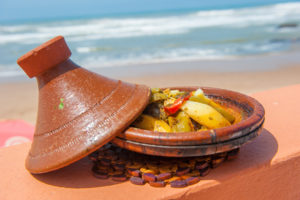 Tagines – the recipes
Tagines – the recipes
Tajine cooking is an art that dates back centuries and recipes have developed over time to include a wide variety of savoury culinary delights. Basically, tagines are a sort of stew that have a rich spicy sauce which is thickened due to the long cooking process and are generally served with bread, couscous or rice. Originally, they would be cooked for many hours, but with modern cookers, a good result can be achieved in a lot less time – bear in mind though, the longer you cook them, the more developed the flavours will be.
Fruits are usually added in dried form and contribute a subtle sweetness to the overall flavour. Often tagines contain preserved or salted lemons, which give the dish a unique flavour which cannot be duplicated by using fresh lemons (see recipe below).
[mrb]
Andrea’s “Orange Dinner” Moroccan Tagine
Serves 4
1 glug of olive oil
1 large onion
4 cloves of garlic, crushed
1 large sweet potato
3 large carrots
1 orange (or red) pepper
150g red lentils
100g dried apricots
500ml passata or 1 large tin of tomatoes
1 tbs harissa (hot chilli paste, widely available)
1 veg stock cube
250ml water
½ tsp turmeric
½ tsp cumin powder
2 tsp dried mixed herbs
400g tin chickpeas
Salt & pepper to taste
Chop all the vegetables chunkily. Rinse the red lentils well.
Fry the onions in olive oil until soft and transparent but not brown. Stir in the garlic and cook for a further minute.
Add the turmeric and cumin and fry for two minutes.
Add the passata/tomatoes, lentils, carrots, herbs, harissa, stock cube and water.
Bring to the boil, stirring so the lentils don’t stick. Simmer for 5 minutes then add the sweet potato and apricots.
Simmer for a further 5-10 minutes, add more water if it becomes too sticky – it should have the consistency of a stew.
Add the chickpeas and the pepper.
Simmer until the lentils and vegetables are cooked (approximately 15 minutes). Adjust seasoning to taste.
Serve with couscous and a large glass of your favourite wine….a nice syrah rosé works well!
Pumpkin, Potato & Butternut Squash Tagine
Serves 4
1 glug of olive oil
1 large onion
2 cloves of garlic, crushed
500g pumpkin
1 small butternut squash
400g potatoes
2 tsp cumin powder
2 tsp cinnamon powder
½ tsp dried chilli flakes
400g tin chopped tomatoes
400g tin chickpeas
½ preserved lemon (see below for recipe)
Salt & freshly ground black pepper
Chop all the vegetables and the lemon chunkily.
Heat the oil and fry the onion until soft and transparent but not brown. Stir in the garlic and cook for a further minute.
Add the cumin, cinnamon and chilli and fry for two minutes.
Add the chickpeas, pumpkin, butternut squash, potatoes and tomatoes. Pour in just enough additional water to cover.
Season with salt and pepper to taste and simmer on a low heat until the potatoes begin to soften, about 30 minutes, add more water if becomes too sticky – it should have the consistency of a stew.
Add the preserved lemon and cook for a further 10 minutes. Adjust seasoning to taste.
Serve with couscous.
Mushroom & Sweet Potato Tagine
Serves 4
1 glug of olive oil
1 large onion
4 cloves garlic, crushed
4 closed-cup mushrooms
300g sweet potatoes
400g tin tomatoes
100g ounces dried apricots
400g chickpeas
1 tbs tomato puree
2 tsp coriander powder
1 tsp cumin powder
2 tsp cinnamon powder
½ tsp chilli powder
200 ml vegetable stock
Salt & freshly ground black pepper
Chop the onions, mushrooms, apricots, and the sweet potato chunkily.
Heat the oil and fry the onion and mushrooms until soft and transparent but not brown.
Stir in the garlic and cook for a further minute.
Add the remainder of the ingredients and reduce heat and simmer for at least 1 hour. If you have the time cook it for longer as this will improve it.
Serve with rice or couscous
Summer Vegetable Tagine
Serves 4
1 glug of olive oil
3 courgettes
4 large spring onions with the greens
1 large red pepper
4 carrots
4 tomatoes
2 medium potatoes
1 cup green beans
1 cup petit pois(fresh or frozen)
400g tin chickpeas
1 cinnamon stick
3 cardamom pods
2 tsp coriander powder
1 tsp cumin powder
½ tsp chilli powder
Juniper berries
handfull French (flatleaf) parsley, chopped roughly
2 tbs dry roasted almonds
2 cups vegetable stock
Wash and chop the vegetables into chunks.
Heat the olive oil and sautée the chopped onion until soft and transparent but not brown.
Add the cinnamon, cardamoms, coriander, cumin, chilli and Juniper berries and fry for 2 minutes.
Add the carrots and potatoes and sautée for a few minutes.
Add the vegetable stock and simmer for about 10 minutes.
Add the tomatoes and red pepper, season with salt and pepper and simmer until the vegetables are tender.
Add the chickpeas and green beans and cook for 5 minutes, or until the beans are tender.
Taste for seasoning and adjust.
Serve sprinkled with the fresh petit pois, roasted almonds and parslay.
Serve with rice or couscous.
Moroccan Preserved Lemons (Mssiya)
6 lemons
500g salt
1 cinnamon stick
¼ cup bay leaves
¼ cup of vegetable oil
Spring water
Quarter the lemons from the top to within 1.5cm of the bottom. Gently spread them without breaking the bottom and pack them with salt and then reshape the fruit.
Place 1 tbs salt on the bottom of a sterilized 500ml jar.
Pack in the lemons and push them down, adding more salt and the other spices, between layers. Press the lemons down to release their juices and to make room for the remaining lemons. Cover the lemons with the spring water and leave enough space for the oil.
Pour in the vegetable oil and seal the jar. The vegetable oil has no effect on the actual flavouring except that it works as a seal and protects the lemons from air contact during the preservation time.
Let the lemons ripen in a cool dry and dark place for at least 30 days before reopening.
To use, rinse the lemons, as needed, under running water, remove the pulp or cook with both pulp and rind, if desired. Sometimes you will see a lacy, white substance clinging to the lemons; it is perfectly harmless, but should be rinsed off for aesthetic reasons.
There is no need to refrigerate after opening. Preserved lemons will keep up to a year, and the pickling juice can be used two or three times over the course of a year.
Preserved lemons, sold loose in the Souks of Morocco, are one of the indispensable ingredients of Moroccan cooking, used in Tagines and salads. Their unique pickled taste and special silken texture cannot be duplicated with fresh lemon or lime juice.
•With thanks to Trevor Bridge
Share to: Facebook Twitter LinkedIn Email
More in cooking, courses, creuse, food, heating, summer, wine
By FrenchEntrée
Leave a reply
Your email address will not be published. Required fields are marked *

